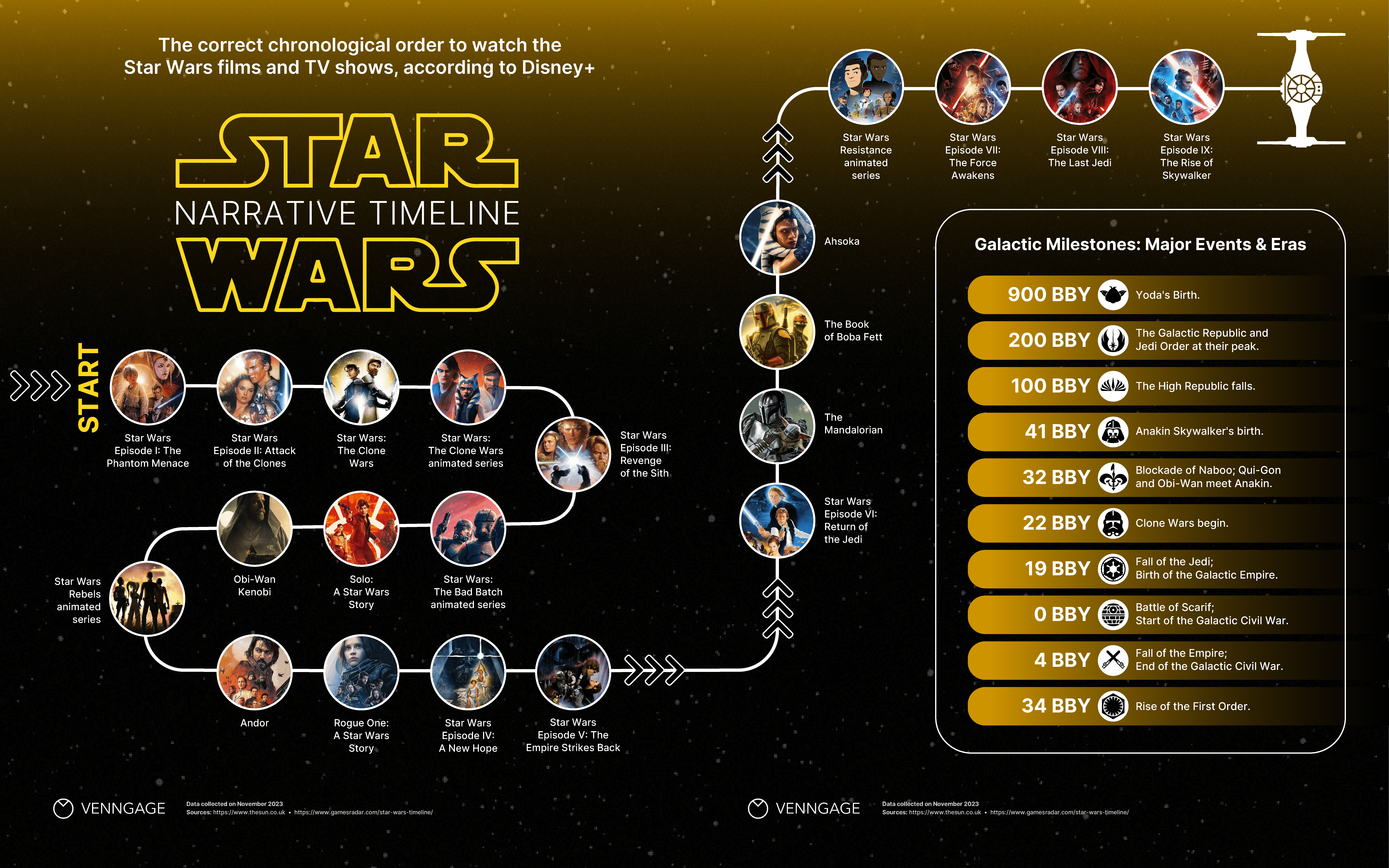
Set in a distant galaxy far, far away, the Star Wars franchise is actually close to people’s hearts.
It all began back in 1977 with Star Wars: A New Hope, but this isn’t where you should start if you want to follow the in-universe chronology.
In fact, figuring out the correct order to watch Star Wars can be difficult because of how George Lucas released the films. And then there’s the minor issue of multiple trilogies, movies, and spin-off series that can make following along all the more confusing.
The foundation of the Universe is in the trilogies, however, the middle trilogy (episodes 4-6) was released first in the late 70s and early 80s because Lucas had already developed these stories. It took him a few decades more to tell the backstory with a prequel trilogy (episodes 1-3) released between 1999-2005.
And a decade after the prequel came the the sequel trilogy (episodes 6-9) under Disney’s ownership.
This non-linear approach has allowed the Universe to expand based on the narrative priorities.

Star Wars timeline
If you want to watch Star Wars without feeling lost, follow this list:
- Star Wars Episode 1: The Phantom Menace
- Star Wars Episode II: Attack of the clones
- Star Wars: The Clone Wars
- Star Wars: The Clone Wars Animated Series
- Star Wars Episode III: Revenge of the Sith
- Star Wars: The Bad Batch Animated Series
- Solo: A Star Wars Story
- Obi-Wan Kenobi
- Star Wars Rebels Animated Series
- Andor
- Rogue One: A Star Wars Story
- Star Wars Episode IV: A New Hope
- Star Wars Episode V: The Empire Strikes Back
- Star Wars Episode VI: Return of the Jedi
- The Mandalorian
- The Book of Boba Fett
- Ahsoka
- Star Wars Resistance Animated Series
- Star Wars VII: The Force Awakens
- Star Wars VIII: The Last Jedi
- Star Wars IX: The Rise of Skywalker
Understanding the Star Wars eras
The Star Wars story covers multiple eras, with key events such as the rise and fall of the Galactic Empire, the evolution of the Jedi and Sith, and the struggle between light and dark forces separating the films and series.
In Star Wars, time is referenced as BBY (Before the Battle of Yavin) and ABY (After the Battle of Yavin).
In case you’re wondering, the Battle of Yavin was pivotal event in Star Wars Episode IV: A New Hope and is represented as year 0.
- Prequel Trilogy Era (32-19 BBY) The prequel series (episodes 1-3) takes place from 32-19 BBY and features events such as the discovery of Anakin Skywalker, the rise of the Galactic Empire, and the fall of the Jedi Order.
- Original Trilogy Era (0 BBY-4 ABY): The original series (episodes IV to VI) spans from 0 BBY to 4 ABY and follows the Rebel Alliance’s struggle against the Empire.
- Sequel Trilogy Era (34 ABY and beyond): The sequel trilogy series (episodes 7-9) deals with the rise of the First Order and a new generation of heroes.
Here’s a recap of major events across the eras:

By the way, standalone films and series like The Clone Wars, Rebels, The Mandalorian, fit within these eras and provide additional context and depth to the Star Wars saga.
Upcoming Star Wars shows and movies
The Star Wars franchise is always releasing new content to keep fans involved, but that also means a longer timeline!
Let’s review some upcoming releases and review how they fit within the Star Wars Timeline.
Star Wars: The Acolyte (2024)
This movie will be set 200 years before Episode 1: The Phantom Menace. This period is known as the High Republic Era when there is peace in the galaxy and the Jedi Order is at its height.
Star Wars: Andor Season 2 (2024)
Set in the prequel trilogy era (32 years before A New Hope), the new season of the Andor will follow the journey of Rebel spy Cassian Andor as he becomes involved in the fight against the Galactic Empire.
Create your own timelines with Venngage
Like this timeline infographic and want to create your own?
Check out our Timeline Maker! Anyone can whip up a stunning timeline like the Star Wars chronology without any design experience.
To get started, sign up for a free account, pick a template from our library of professionally-designed timelines, swap in your content, and you’re ready to go!





































